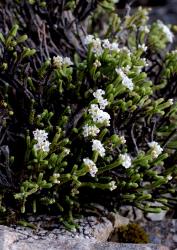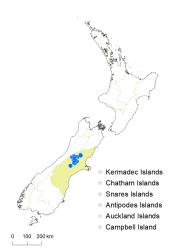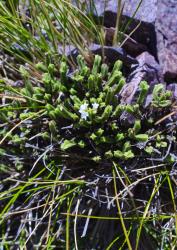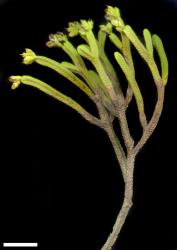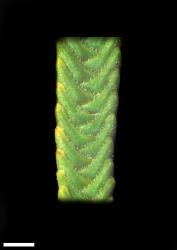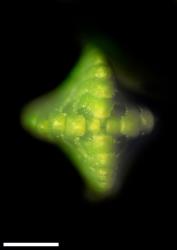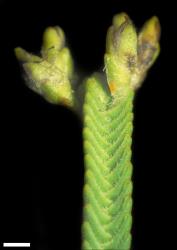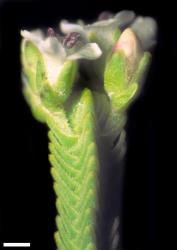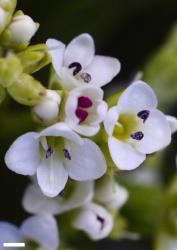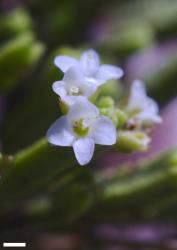- ≡ Hebe tetrasticha (Hook.f.) Andersen, Trans. New Zealand Inst. 56: 694 (1926)
- ≡ Leonohebe tetrasticha (Hook.f.) Heads, Bot. Soc. Otago Newsl. 5: 5 (1987)
Straggling semi-whipcord shrub to 0.2 m tall. Stems decumbent or ascending, glabrous. Leaf bud indistinct, its outer leaves fully grown, diverging. Leaves opposite-decussate, connate in pairs and encircling stem, erecto-patent, densely crowded and overlapping; lamina sub-coriaceous, deltoid-subulate, 1.0–2.8 mm long, 1.0–2.8 mm wide, dull green above and beneath; veins not evident; surfaces glabrous; margin ciliolate or shortly ciliate (except at apex), entire; apex acute; bases broad; petiole absent. Inflorescence a lateral spike, 3–7 mm long; flowers crowded, 2–6, female or male on separate plants, ♂ > ♀; bracts opposite-decussate, free or barely connate, deltoid, >pedicels; pedicels erect-patent, 0–0.7 mm long, eglandular-pubescent all around. Calyx lobes 4, obtuse, equal, 1.5–2.5 mm long, mixed glandular- and eglandular-ciliolate (glandular often obscure). Corolla 2.5–4.5 mm diameter (♂ > ♀); tube white, 1–2 mm long, < calyx, glabrous; lobes 4, white, erecto-patent to recurved, sub-equal, elliptic to ovate to deltoid, 1.0–2.5 mm long, obtuse; nectar guides absent. Stamen filaments white, 0.7–1.5 mm long; anthers pink (pale in ♀ flowers). Style glabrous, 0.8–2.5 mm long. Capsules angustiseptate, obtuse, glabrous, 2–3 mm long, 1.5–2.5 mm at widest point. Seeds ellipsoid to oblong, flattened, smooth or finely papillate, pale brown to orange, 0.8–1.0 mm long.
V. tetrasticha belongs to a well-supported clade of four species, the semi-whipcord hebes; the other species are V. hookeri, V. quadrifaria, and V. tumida. Relationships within this grouping are unclear.
Semi-whipcord hebes are characterised, and distinguished from true whipcord hebes, by very crowded, dull green, scale-like leaves that are long-persistent on old stems, dioecious sexual systems, and angustiseptate capsules.
In V. tetrasticha plants the leafy stem is shallowly grooved on the faces, compared with rounded in V. tumida and flat in V. quadrifaria plants. This is because the leaves of V. tetrasticha plants tend towards subulate with an acute apex; in dry specimens their margins are inrolled in the middle portion of the leaf, whereas those of V. quadrifaria are straight. V. hookeri plants have stems that are cruciform in cross-section because the apical portions of the leaves are longer and more or less oblong from a broader base, compared with the shorter leaves of V. tetrasticha and V. quadrifaria. Also, V. hookeri leaves are minutely flattened at the swollen apex with a small, sunken hydathode, compared to the acute apex and absent hydathode on V. tetrasticha leaves.
The differences between V. tetrasticha and V. quadrifaria are slight and not always clear-cut (see detailed discussion in Bayly & Kellow 2006).
South Island: Westland (Upper Otira Valley), Canterbury (Puketeraki Range, Craigieburn Range, Torlesse Range, Big Ben Range, Mt Somers).
Alpine rocks and scree, occasionally establishing at lower altitudes in rocky places. Recorded elevations range from 860 to 1952 m.
Flowers: November–January; fruits: December–February.
2n = 42 (see Bayly & Kellow 2006, as Leonohebe tetrasticha).
Veronica tetrasticha is classified in V. subg. Pseudoveronica sect. Hebe and informally in the “semi-whipcord hebe” group (Albach & Meudt 2010).



